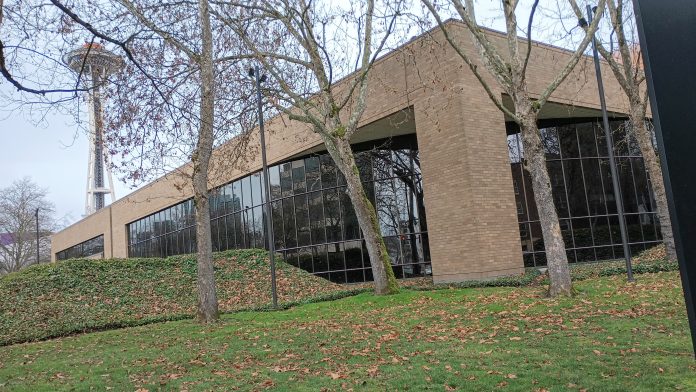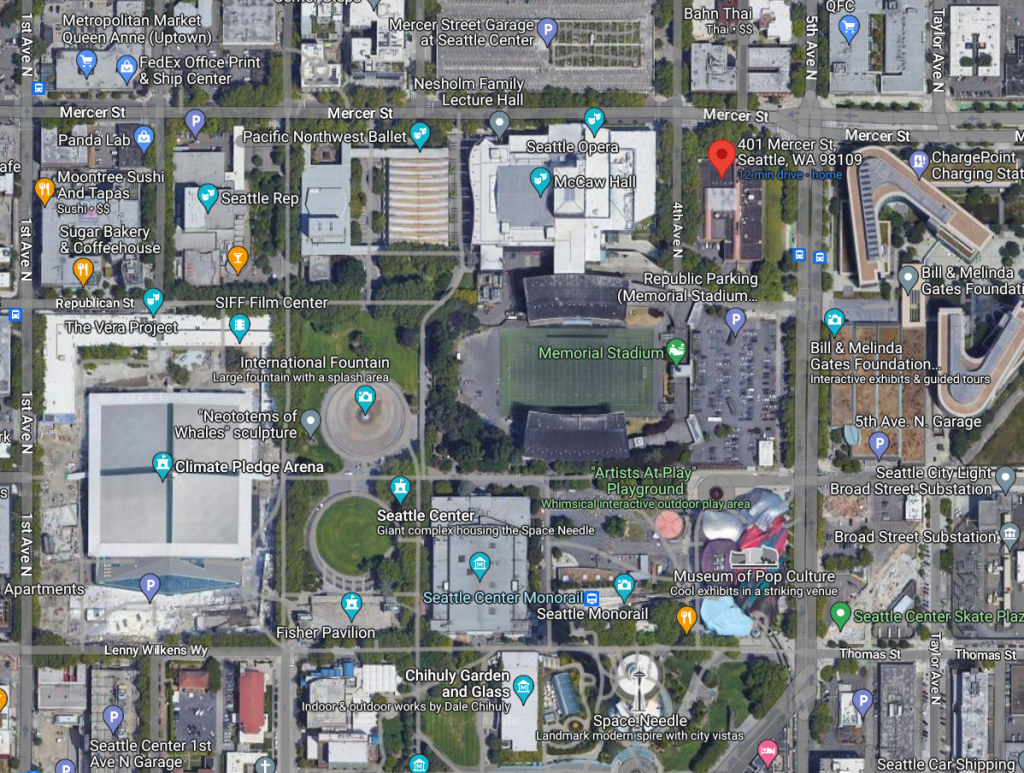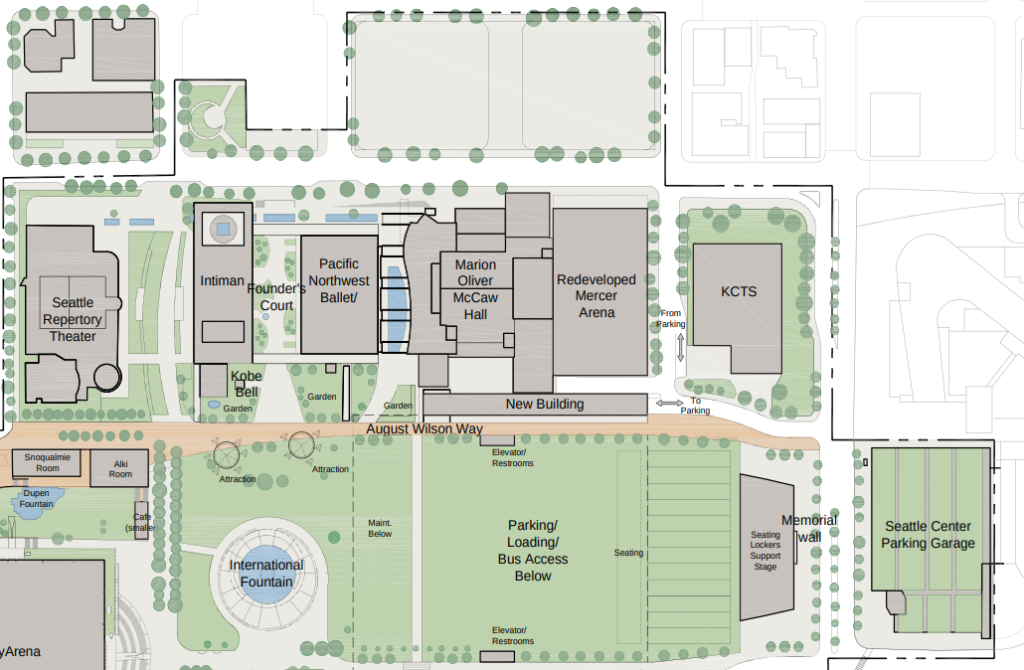
Most frequently used by high school sports participants, Bill and Melinda Gates Foundation employees, and Seattle Opera goers, the northeast corner of Seattle Center is probably the quietest area of the 74-acre public campus. Most visitors to Seattle Center likely pass by without noticing the nondescript office building, set back from the street near the corner of 5th Avenue and Mercer Street, where KCTS 9 public television has had its offices since 1986, and where the online news outlet Crosscut has its offices as well. But a coming change opens the door to new possibilities, particularly if the City of Seattle seizes the chance to leverage the opportunities set to become available.
Last year, Cascade Public Media, the umbrella organization that includes KCTS and Crosscut, announced that they were moving all operations to First Hill by the end of 2023, ending their current lease at Seattle Center. Their 401 Mercer Street building, which is around 66,000 square feet across two floors, sits on an 88,000 square foot lot and is separated from the rest of Seattle Center by roads owned by the Seattle Department of Transportation (SDOT), unlike the pedestrianized streets inside the campus controlled by Seattle Center. And its coming vacancy could represent a big opportunity to rethink how that entire area of Seattle Center operates.

Last year, a consultant contracted by Seattle Center looked at potential near-term uses for the space in the wake of KCTS’s departure. The Jacobson Group, which specializes in commercial real estate, submitted its report to the department in October.
“Seattle Center’s long term plan, which reflects support from community and stakeholder outreach, is to pursue a redevelopment strategy for the site that will generate revenue to support Seattle Center, and contribute to the overall vitality of the campus and the neighborhood,” the report notes. “In the interim period, Seattle Center is evaluating possible uses that will replace annual rental revenues in the short term, keep the building safely maintained, and/or help address some short-term space needs for the campus.”
Jacobson recommended that the city pursue a ground lease, which would be long term, in order to generate the most revenue. Ground leases are fairly common for governments to pursue, with the City of Seattle using them in cases like Magnuson Park’s affordable housing development and Sound Transit for the transit-oriented development at Capitol Hill Station.
But given the relatively short timeline before KCTS vacates the space, the report also lists some short-term uses for the space while the city pursues that ground lease. The City came under fairly intense criticism for not pursing a ground lease for the Mercer Megablock, instead outright selling the property. That doesn’t appear to be on the table here.
“The building in its current condition is more conducive to warehouse and storage uses. The two-dock high and one ground level loading docks are a plus in a location and economy where logistics facilities are in demand…Although 10-year lease terms are generally preferred, 5-year terms would likely still attract tenants,” the report explains.
The space in its current condition is less likely to attract office use, given the other options around downtown, but it does note the potential for other arts-adjacent uses like music recording space or for use as a rental to some of the theater companies that use nearby performance spaces at Seattle Center.
The report also briefly touches on some other potential near-term uses, including storage space for a wide variety of city departments, or potential use as a site for the Seattle Center’s maintenance facility, which is currently not on campus.
But the report is fairly brief when it comes to what the long-term potential for the site could be, stating that “[t]he site is ideally located for a mixed-use development. Arts and culture and retail on the ground floor, hotel, affordable housing, and other residential uses above ground would all be desirable for the neighborhood.”
Constructing housing directly on the Seattle Center campus would be a departure from decades of precedent, but would likely do as much or more to activate that area of the campus as office space, particularly with a high traffic use on the first floor. The 12th Avenue Arts building on Capitol Hill, with its two performance spaces below affordable rental units, shows one potential model. What happens next is likely going to be guided by how fast the City wants to move, and how broad its current imagination is.
Finding a long-term vision
What ends up happening in this corner of Seattle Center would normally be shaped by the city’s existing plans…but many of those are now out-of-date. The Seattle Center Century 21 master plan, adopted in 2008, tried to shape the years ahead by outlining some overarching goals for how Seattle Center would respond to changes happening both within and outside the campus.
The Bill and Melinda Gates Foundation headquarters, which opened in 2012 across 5th Avenue N, was seen as providing a new opportunity for that corner of campus. But many of those opportunities are focused around the redevelopment of Memorial Stadium, owned by Seattle Public Schools, only small progress toward any change in the years since the adoption of the plan.

The Century 21 plan envisions remodeling Memorial Stadium to be more open, with August Wilson Way, the extension of Republican Street within Seattle Center, providing a walking and biking thoroughfare through campus. A key component of that plan is a new parking garage, constructed underneath the stadium, but ultimately as a trade: 1,300 stalls have been envisioned, replacing both the surface stalls that currently blight the streetscape along 5th Avenue N and also the approximately 1,400 that exist in the aging city-owned Mercer Garage nearby.

Movement is expected on the Memorial Stadium site in the coming years. The 2022 capital levy passed by voters includes funds to upgrade the facility, though those will almost certainly need to be combined with private dollars, and perhaps even some city ones, to achieve the vision for a new Memorial Stadium that everyone will want to see. For years, the vision for a new stadium has been one that is used for school-related activities but becomes available for public activities in off-hours.
In the official campus plan, the KCTS property is not envisioned as going anywhere. But if the coming vacancy can be leveraged with the potential changes at Memorial Stadium, and (eventually) for the Mercer Garage — which is now required to be retained as potential parking for Climate Pledge Arena until Sound Transit light rail arrives in Uptown — then the potential opportunities widen substantially.
A key issue: revenue generation
This next phase of potential changes at Seattle Center brings to mind some of the last significant redevelopment projects on the campus. In 2010, when the lease on the Fun Forest amusement park directly underneath the Space Needle expired, the Space Needle’s owners, led by Jeff Wright as board chair, moved to expand by proposing a museum devoted to glass artist Dale Chihuly’s work. Wedging a new museum into that space wasn’t in the campus plan, but the idea of a new source of revenue that wouldn’t require any investment on the part of the city was too enticing to pass up.
When the Chihuly Garden and Glass museum was first proposed, some leaders did acknowledge the decision that moving ahead would be closing the door on some of the anticipated vision for central Seattle’s largest swath of open space.
“We’re taking green, open space and closing it off in a very walled fashion, and people can only enter into that if they can pay. My hope and dream would be to make the Seattle Center Seattle’s ‘Central Park,’ and the more green space we give away, the less we’re going to have a Central Park,” Councilmember Sally Bagshaw, then chair of the Parks and Seattle Center committee, said in 2010. But by the next year, Bagshaw was convinced, and voted for the Chihuly proposal. “Seattle will have another world-class attraction and Seattle Center will be further invigorated,” she said in 2011.
That whirlwind of a public process, with very few alternatives really on the table, left a bad taste in the mouths of a lot of Seattle residents. There was even less civic conversation about the trade-offs involved in tearing down the Mercer Arena, between KCTS and McCaw Hall, and replacing it with office and events space for the Seattle Opera, which opened in 2018.
Unlike Seattle Parks or SDOT, Seattle Center gets most of its revenue from activities and leases from the campus itself. But taking a broader view of what’s in the long-term interest of Seattle Center could benefit the entire city. And one thing that has always prevented Seattle Center from actually becoming the city’s Central Park is the focus on events, with foot traffic always dwindling in between. But the opportunities that are coming represent a big opportunity to rethink that.
For now, Seattle Center isn’t saying much about the potential uses for the property. “With the lease for KCTS up at the end of this year, Seattle Center is currently preparing for shorter-term uses of the space until a long-term plan is made,” Jayme Stocker, a spokesperson for Seattle Center said. “While no concrete plans have been made, the City plans to eventually seek a development partnership that will provide programming and financial support to sustain Seattle Center’s campus into the future. The community will be involved in the planning/visioning process, including neighbors and resident organizations of Seattle Center.”
This year, Seattle Center has a new Director, Marshall Foster. Foster has been heavily involved in shaping the city’s vision for how it uses public space for over a decade, shepherding the entire waterfront development from his position as head of the Office of the Waterfront and Civic Projects. Like with the waterfront, there are big opportunities to navigate at Seattle Center, but if it all comes together, it could be phenomenal.
Ryan Packer has been writing for The Urbanist since 2015, and currently reports full-time as Contributing Editor. Their beats are transportation, land use, public space, traffic safety, and obscure community meetings. Packer has also reported for other regional outlets including BikePortland, Seattle Met, and PubliCola. They live in the Capitol Hill neighborhood of Seattle.

